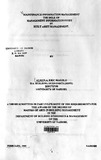| dc.description.abstract | The construction industry plays a leading role in the development of any country by
producing investment goods. These provide habitats for activities, economic or otherwise, in
which people are engaged. They are aimed at increasing the infrastructural base of any nation
desirous of meaningful development. In this regard, many countries have heavily invested in
such facilities as roads, bridges and buildings of various types, amongst others. These
facilities need to be adequately maintained. To be able to do so there is need for appropriate
maintenance management systems. A crucial component of these systems is the maintenance
management information system. Its role is to provide proper information that is required to
ensure adequate maintenance.
The study was prompted by concern for the declining standards of maintenance of
built assets in the country and the noticeable trend in the manner in which organisations were
applying crisis as opposed to the more effective planned maintenance approach. This was
despite evidence which indicated that crisis or response based maintenance was twice as
expensive as the planned maintenance regime (UNCUS, 1990 and UNCUS, 1991). A
survey carried out to determine the maintenance status of built assets established the fact that
many residential buildings are in a declining state of repair (Syagga and Aligula, 1993) .
Some
studies have also Linked the poor maintenance state to the technical features such as the
design parameters and labour productivity (Syagga, 1985; Mbucua, 1988 and Rukwaro,
1991). Other studies and authors have attributed this poor state of maintenance of built assets
to different factors, namely: poor management, inadequate funds, staff and transport to name
just a few (Aloo, 1985; Syagga, 1985; Miles and Syagga, 1987; and Mbucua, 1988). This
study however, in addressing the poor state of the built environment stated that these were only symptoms of a more fundamental flow in the management of built assets: the
maintenance management information system. In this respect the study's contribution was
that it addressed an organisational problem rather than the technical issues which a number of the other studies dealt with The study is divided into six chapters. The first chapter deals with the background
and problem definition and research methodology issues. Replication logic is the mode
chosen to analyse the data collected in the field. In using this logic it was necessary to
develop a theoretical framework which set out the conditions under which effective and
efficient maintenance information management could be carried out. This is secured in
chapters two and three. Chapters four and five describe the case study areas and discussed
the nature of information management practices at the Nairobi City Commission and the
Kenya Breweries Limited. It shows the four levels of the maintenance management
personnel,the activities they undertook and the information that they needed to carry out this
activities.It was seen that a lot of the information that they indicated that they required was
not available to them. For instance,they did not have information relatingto the maintenance
backlog and the condition of the housing units. It was thus, impossible for them to
effectively plan and execute their activities.
Chapter six.provided the summary of findings, conclusions and recommendations of
the study. The main findings were that their was a lack of a comprehensive maintenance
policy which would not only define the roles of the participants but also focus the efforts of
the maintenance personnel other finding was that there was under maintenance at the
NCC and KBL running a t20.6-and 24.6 percent respectively. This was a conservative
estimate.A more in-depth survey would definitely show a higher rate. When this was linked
to the fact that around 70 percent of the interviewees for the user-reaction surveys indicated
that their dwellings were not inspected at all or that it was not regular. It was clear that the
maintenance personnel had no access to the information about defects in the dwellings until
they are summoned. Maintenance request procedures were found to be bureaucratic and it
(
was recommended that this be reviewed to make them simpler but still be able to ensure
financial accountability. Data that ~as found in the maintenance departments in the study
areas was foundto be compatible with such useful techniques as Life Cycle Costing. This
was made worseby the reluctance of the maintenance personnel to accurately complete the
from which such data could be retrieved. Use of computers was recommended given
the large number of units and therefore the data to be handled. Changes in the manner in
which the information was classified were recommended so that information could be easily retrieved and analysed. There was a distinct need to educate the maintenance personnel on the pertinent need to ensure that the forms, such as building work orders, needed to be properly completed. Last, but not least the study recommended that a review of the manner in which maintenance was organised be made so that tasks, information needs and the personnel are properly matched | en |

